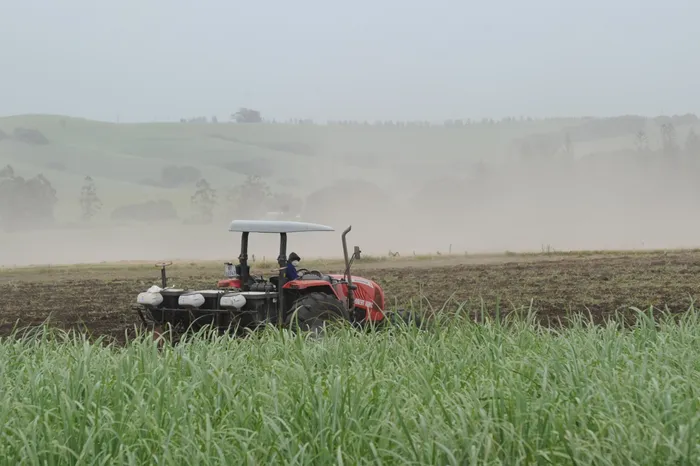Navigating SA’s 2025 grain outlook: a delicate balance between abundant harvests and rising food costs
AGRICULTURE

Rising input costs for fertilisers, seeds, and machinery add financial strain on farmers, which may lead to higher consumer prices, affecting vulnerable populations. Additionally, global market dynamics, including changes in trade policies and commodity prices, further complicate the situation.
Image: Karen Sandison/ Independent Newspapers
As South Africa approaches the 2025 agricultural season, the outlook for staples like maize, wheat, and soybeans is complex and critical for food security and consumer prices. Although strong harvests are expected, unpredictable climatic conditions such as droughts and excessive rainfall pose risks to crop yields.
Rising input costs for fertilisers, seeds, and machinery add financial strain on farmers, which may lead to higher consumer prices, affecting vulnerable populations. Additionally, global market dynamics, including changes in trade policies and commodity prices, further complicate the situation.
While there is optimism about harvest yields, these interconnected factors create uncertainty for agricultural stability and food prices.
Stakeholders—including policymakers, farmers, and consumers—must remain adaptable to address the challenges ahead and ensure food security.Maize: A Double-Edged SwordThe Crop Estimates Committee (CEC) forecasts a commercial maize crop of 14.664 million tons for 2025, indicating a 0.72% increase from previous estimates and a 14.12% rise from 2024. This growth is primarily due to favourable weather conditions and an expansion in farming areas.
However, the potential benefits of this bumper crop may be diminished by rising production costs. Escalating prices for fertilisers and fuel, driven by global supply chain disruptions and geopolitical tensions, are significantly increasing input costs for farmers.
For consumers, especially those in low-income households, maize meal—a staple food—has become less affordable, with prices steadily climbing over the past year.
This situation raises concerns about food security for many families.Wheat and Soybeans: Promising Yet VulnerableThe wheat harvest for 2025 is projected at 2.3 million tons, a 26% increase year-over-year, driven by improved yields and consistent planting areas.
Similarly, soybeans are expected to yield 2.3 million tons, benefiting from better yields and a stable planting area.
These gains are crucial for both human consumption and animal feed, impacting food inflation and livestock production costs.
Despite these optimistic projections, the agricultural sector remains vulnerable to climatic fluctuations.
The El Niño phenomenon, which has caused prolonged heat stress and adverse rainfall, continues to pose a threat to crop yields and food security.Implications for Food Security and Consumer PricesIncreased production of staple crops like maize can play a significant role in addressing food price pressures, but it is essential to recognize that the benefits of such production are not always guaranteed.
For example, while higher yields can lead to an abundant supply, this abundance does not automatically translate to lower prices for consumers or increased profitability for farmers.
In the context of South Africa, several factors intertwine to influence maize prices. Global competition plays a crucial role, as farmers must compete with imported maize, which can fluctuate significantly in price due to international market conditions.
Additionally, local challenges such as exchange rate fluctuations can further complicate the pricing landscape. When the South African rand weakens, the cost of imported goods increases, putting additional pressure on local producers to maintain their price points while also managing rising production costs.
The anticipated decline in maize prices that may result from increased production can pose challenges for farmers. While consumers may benefit from lower prices, farmers could see their profit margins shrink, leading to potential issues regarding the sustainability of local agriculture. Farmers may struggle to cover their costs, invest in their operations, or make a reasonable living if prices fall too low, which could discourage long-term investment in farming activities.
For consumers, particularly those living in rural areas or low-income urban settings, the rising cost of staple foods like maize meal is a pressing concern.
Food security is a critical issue, and when prices rise, it can push necessities out of reach for many families. In 2022, approximately 25.8% of the population experienced food insecurity, a figure that was likely exacerbated by ongoing economic pressures and rising inflation rates. As these economic challenges persist, families are often forced to make difficult choices between purchasing food, paying for utilities, or other essential expenses.
Policy RecommendationsTo navigate these challenges, a multifaceted approach is essential:Support for Farmers: Implementing subsidies for fertilisers and fuel, as well as providing access to blended finance packages, can help mitigate rising production costs and support farmers' profitability.
Strategic Trade Policies: Enhancing trade agreements and resolving regional trade frictions can secure export markets and stabilise prices, benefiting both producers and consumers.Consumer Protection: Monitoring price trends and implementing short-term interventions, such as zero-rated VAT on basic foodstuffs, can help protect vulnerable households from escalating food costs.
Investment in Agricultural Innovation: Encouraging the adoption of drought-resistant GMO seeds and precision agriculture can improve yields and reduce environmental impact, ensuring long-term food security.
The 2025 grain outlook for South Africa presents a paradox: abundant harvests shadowed by rising costs and climatic uncertainties.
While increased production offers hope, it is not a panacea for the challenges facing food security and consumer prices. A balanced approach, combining support for farmers, strategic policies, and consumer protection, is crucial to ensure that the benefits of a bumper harvest reach all South Africans.

Dr Thulasizwe Mkhabela is an Honorary Research Fellow with the African Centre for Food Security and the University of KwaZulu-Natal
Image: LinkedIn
Dr Thulasizwe Mkhabela is an Honorary Research Fellow with the African Centre for Food Security and the University of KwaZulu-Natal and an independent agricultural researcher and policy analyst. He is also a director and Senior Researcher at Outcome Mapping.
BUSINESS REPORT
Visit: www.businessreport.co.za